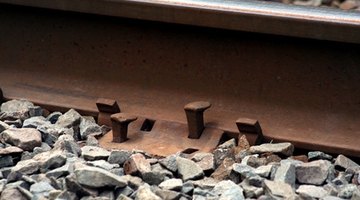Types of Railroad Hammers
Railroad construction is a heavy and laborious process requiring a high degree of expertise and the use of specialized tools. Perhaps one of the most important of these tools is the railroad hammer, a unique instrument used to drive iron spikes into the wooden foundation ties that hold the rail track together. Over the years, the railway system in America and other parts of the world has changed in many ways, but the essential design of rail track has remained the same, as have the tools of its basic construction: the hammer and the spike. There are essentially three types of railroad hammer that have been used to construct and maintain railways over the past 150 years.
Spike Hammer

The spike hammer, a specialized sledge hammer with a flat, heavy head, was designed to deliver a great amount of force to the top of a rail spike. This was the workhorse tool used in the construction of the great American Union Pacific rail line during the mid-1800s. It required a tremendous amount of manual labor on the part of the worker using it. Today, the spike hammer or sledge hammer still is used for small maintenance and repair operations on rail track but has been superseded by more advanced machines for large-scale spike laying.
Spiker
Although the term "spiker" once was used as a term for the men who manually hammered spikes, it refers today to a large, automated machine that rides on top of rail tracks and drives spikes into rail ties via a high-powered pneumatic system. The spiker requires little manual labor on the part of the operator and can drive spikes with a greater degree of accuracy and efficiency than a worker with a spike hammer. It is also more cost-efficient for the simple reason that it means fewer workers are required to lay a greater number of spikes over a shorter period of time. It is the equivalent of a nail gun to a simple hand hammer and is the most common method of laying spikes on modern railways.
Jackhammer
The jackhammer, or pneumatic drill, often is used in railway construction as a demolition tool to clear rocks or debris that might lie in the path of a new rail track. It also may be used in emergency situations by maintenance crews to break up rock that has fallen on the tracks from a landslide or earthquake to allow the safe passage of freight and passenger trains. Although not as specific to railway construction as the spike hammer and the spiker, the jackhammer is still an important tool in the arsenal of railway construction and general maintenance.
Writer Bio
Evan Arnage has been writing professionally since 2004. He is a writer and new media producer with a background in commercial film making, online advertising and social media dynamics. His work has been featured in such publications as "The Kitchener-Waterloo Record" and "NOW Magazine." Arnage has a joint Bachelor of Arts in film studies and media information-technoculture from the University of Western Ontario.
Photo Credits
- Railroad spikes image by Jim Mills from Fotolia.com
More Articles



